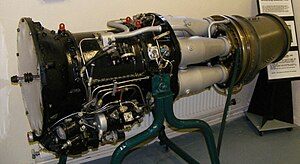Armstrong Siddeley Mamba
| Mamba | |
|---|---|
 |
|
| ASM.3 engine at the Armstrong and Aircraft Museum at Bamburgh Castle. | |
| Type | Turboprop |
| National origin | United Kingdom |
| Manufacturer | Armstrong Siddeley |
| First run | April 1946 |
| Major applications |
Boulton Paul Balliol A.W. Apollo Short Seamew |
| Developed into |
Armstrong Siddeley Double Mamba Armstrong Siddeley Adder |
The Armstrong Siddeley Mamba was a British turboprop engine produced by Armstrong Siddeley in the late 1940s and 1950s, producing around 1,500 effective horsepower (1,100 kW).
Armstrong Siddeley gas turbine engines were named after snakes.
The Mamba was a compact engine with a 10-stage axial compressor, six combustion chambers and a two-stage power turbine. The epicyclic reduction gearbox was incorporated in the propeller spinner. Engine starting was by cartridge. The Ministry of Supply designation was ASM (Armstrong Siddeley Mamba). The ASM.3 gave 1,475 ehp and the ASM.6 was rated at 1,770 ehp. A 500-hour test was undertaken in 1948 and the Mamba was the first turboprop engine to power the Douglas DC-3, when in 1949, a Dakota testbed was converted to take two Mambas.
The Mamba was also developed into the form of the Double Mamba, which was used to power the Fairey Gannet anti-submarine aircraft for the Royal Navy. This was essentially two Mambas lying side-by-side and driving contra-rotating propellers separately through a common gearbox.
A turbojet version of the Mamba was developed as the Armstrong Siddeley Adder, by removing the reduction gearbox.
An Armstrong Siddeley Mamba is on static display at the Midland Air Museum, Coventry Airport, Warwickshire and at the Royal Air Force Museum Cosford.
...
Wikipedia
